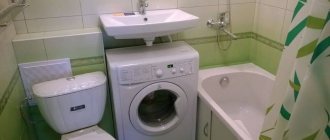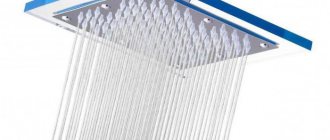A person’s fierce battle for every square meter in an apartment sometimes leads to very unusual ideas. The symbiosis of a sink and a washing machine can also be classified as creative solutions. It may seem to the average person that this equipment, which vibrates during operation, and an element of the bathroom plumbing equipment cannot be combined in any way, but the combination has already been tested in practice more than once. It turned out that this couple got along well. Of course, with some minor adjustments: you need a special sink and not every washing machine is suitable. However, these are little things that do not interfere with turning a bold idea into reality. So, let's find out how to properly place a sink above a washing machine, and what to consider if you plan to do it yourself.
Peculiarities
To combine with a washing machine, you need a special flat-shaped washbasin. In everyday life it is called a “water lily shell.” The product is not in short supply, so you can buy it in almost any large plumbing store. The machine also needs a specific one - its height should not exceed 0.7 m, with the generally accepted standard being 0.85 m. For an ordinary person, a washstand that is located at a distance of 0.8 m from the floor is considered convenient. 0.1 m is a “margin” for the height of the sink itself and an additional 3 cm (the minimum distance between the appliance and the bowl). When installing a washbasin, a “visor” is provided that hangs over the machine by at least 5 cm. This “protrusion” will protect the unit from water droplets. During installation of the machine, be sure to check the quality of the wire insulation, since the risk of water getting on them remains high. If there is a sewer pipe directly under the sink, its minimum width should be 0.58 m. If there is no pipe, then the permissible width criterion is reduced to 0.5 m. The sink pipes must be led outside the unit body. Do not forget about their inaccessibility in the case when it is necessary to re-fasten connections that have shifted due to vibration of the machine during operation.
Advantages and disadvantages
If you place the sink above the washing machine, the owners will receive several pleasant “bonuses”:
- Space saving. This is the most important advantage of such a solution. Washing machines, despite the trend of reducing their size, still take up a lot of space in the bathroom and, in rare cases, in kitchens. In cramped rooms and combined bathrooms, it is generally difficult for them to find a corner. By placing the machine under the sink, you can free up space. Standard shelves, which usually occupy a cabinet with a drain, can be installed in the vacated area (and the storage system can be placed many times larger than the one that was originally huddled under the sink bowl).
- Since a non-standard solution is gaining momentum in popularity, most stores sell special sinks that are designed specifically for symbiosis with a washing machine. The range of models is not poor, so there is plenty to choose from. The list of shortcomings is almost equal to the list of advantages of the interior solution, so it can be safely classified in the “50/50” category:
- The protruding corners of the machine interfere with free movement near the sink. At first, household members may even get bruises and “test” their sharpness with their little fingers out of habit. Over time, the family will get used to this addition to the sink.
- Frequent blockages. The drain design will be non-standard. In the traditional version, water flows down a vertical drain. Here it will accumulate in a horizontal pipe, which will contribute to its stagnation.
The “formal” disadvantages include the need to purchase a siphon of a special shape, which is not included in standard kits. For the sake of this detail, you may have to knock on the threshold of more than one plumbing store.
Subtleties of choosing a sink for a small washing machine
For special equipment you will need a special sink. Why? Because standard sink models will not be able to cover the upper part of the equipment, and the machine itself will “stick out” greatly. And it’s also not very comfortable for your knees - they will constantly hit the washing machine. For machines, special sinks are chosen - “water lilies”, with a drainage depth of up to 20 centimeters. There are many models of “water lilies” and among them there are design features that should be taken into account when choosing a sink.
- Models with a hole for the faucet - if you purchase such plumbing fixtures, add a few more centimeters to your measurements, since such a sink will be located at a distance from the wall
- A sink above a washing machine without a hole for a faucet - this model involves installing a faucet in the wall near the sink, which saves another two to four centimeters. It’s worth choosing this plumbing fixture if, as they say, “every centimeter counts” in your bathroom and you try to save space as much as possible
- Models with a bottom drain - such a sink will limit the free space for the machine, but it has its own advantage - the risk that the plumbing will become clogged will be minimal. If you choose this model, its width should be about 60 centimeters to protect the washing machine under the sink
- Plumbing with a rear drain is more convenient for installing equipment, but less practical in terms of blockages - such models most often cause water to stagnate. But, if you decide on such a sink, its width can be about 50 centimeters
What is also important is that the washing machine should not come into contact with the plumbing drain, so that vibration during operation does not damage the pipes and water does not flow onto the body of the equipment. Yes, choosing a washing machine for the sink and the sink itself will not be easy. To simplify the task, you can look at ready-made kits - “machine + sink”, where the manufacturers independently calculated all the dimensions. Such sets may have an additional countertop on the side near the sink. But they are suitable for a wider bathroom and, by the way, the washing machine can be placed not under the sink itself, but under a flat countertop.
It will be interesting What are clothes drying machines? Let's take a closer look
Types and features of choosing sinks
As mentioned above, only water lily sinks are suitable for combination with a washing machine. This type of washbasin is classified into different types depending on the shape, size and materials of manufacture. There are models with and without a hole for the mixer. In the latter case, the plumbing fixture can be mounted on the wall, thereby freeing up the washbasin for placing cups with toothbrushes and a soap dish.
Materials
Water lily sinks are made from the same materials as other washbasin models:
- Ceramics. Two types of materials are used to make sinks: porcelain and earthenware. Compared to metal, they both have a lot of weight. Unlike earthenware, porcelain is more expensive, has a noble whiteness, is less porous and rarely develops small cracks on the top layer of glaze during long-term use.
- Glass. A stylish, modern solution that is suitable for bathrooms decorated in high-tech, techno, futurism, and avant-garde styles. Glass combines perfectly with chrome surfaces. Unlike ceramics, the material weighs less. Manufacturers offer a wide variety of color solutions: from plain sinks to original models with an ombre effect and streaks. Glass is a durable, durable material. However, it is afraid of detergents with an abrasive effect and requires daily cleaning, since smudges and traces of dried water droplets are noticeable on the surface. A glass sink will cost several times more than a ceramic washbasin.
- Metal. Compared to stone and ceramics, the material is lightweight. It is durable, and with careful use (regular cleaning with non-abrasive compounds) it will retain its original appearance even after years of use. The material cannot be damaged or split when drilling technical holes. The disadvantages of metal sinks include only an increase in the noise of flowing water, which does not happen when the flow collides with ceramics or stone.
- Stone. Natural stone is rarely used to make water lilies. Among all types of materials, it has the most impressive weight, which creates difficulties when installing a washbasin (very reliable fastenings are needed). However, stone is an environmentally friendly material, it is not afraid of absolutely anything and fits perfectly with the popular eco style. The artificial analogue is cheaper, visually practically no different from the original, but can break if the washbasin is dropped during installation.
It is very rare to find sinks made of plastic and wood on the domestic market. The first ones have not yet reached our country and have not taken root in local plumbing stores, but are gaining popularity abroad. Wooden sinks are considered exclusive, which are not durable, but will certainly amaze guests with their colorfulness and originality.
Shape and size
Water lily shells are available in five variations of shapes:
- Semicircular and round;
- Square;
- Rectangular;
- Angular;
- Non-standard forms.
The latter option can be found in designer collections of expensive plumbing fixtures. Such an exclusive is not suitable for budget options. As for sizes, water lilies are available in many variations, among which the following models lead the variety:
- Mini or Compact. Its dimensions are only 50x64 cm. The rectangular washbasin is compactly placed in any corner of the bathroom.
- Light. Dimensions 60x61cm. The model is notable for the presence of an offset drain and the absence of a hole for the mixer.
- Luxe Light. It differs from the “simple” Light version by only 1 cm; the dimensions of the model are 60x62 cm.
- Bolero. The dimensions of this round corner model are 60x64 cm.
There are also models with the euphonious names “Deal”, “Uni”, “Victoria”, “Elegant”. They differ not only in size, but also in shape. Most models are available in only one variation (according to the material used).
Drain
Water lily sinks can have a horizontal or vertical drainage system. The latter is considered more convenient, since water under pressure goes down faster, which reduces the risk of blockages. The “water lily” together with the washing machine can only have a horizontal drain. This feature is due to the increased danger of contact with electric current. The water will drain slowly, periodically stagnate in the sink and, unfortunately, washing your hands for a long time without turning off the tap will not work. There are non-standard models (usually corner ones), in which the drain is located on the side.
Features of choosing washing machines
The height of the machine should be 0.7 m. The combination is selected based on the ease of use of the sink. If the machine is taller, this will not interfere with installing a washbasin, but washing your hands and washing your face will not be very comfortable for a person of average height. There is no shortage of washing machines with a height of 0.7 m, as well as water lily bowls. Many well-known companies produce such products, but you still have to sacrifice something: they do not have a large capacity. You can load no more than 3.5 kg of laundry into the drum. If a lot of things accumulate, then the washing process will have to be repeated many times, which is not very convenient for large families.
Features of washing machines under the sink
The main feature is the size of the equipment. Standard models have a height of 85 cm; of course, such dimensions simply will not fit under the sink. Therefore, a compact machine will have:
- Height no more than 70 centimeters
- Width up to 51 centimeters (the narrowest washing machine under the sink can be 44 cm wide)
- Front loading method
- Functions of a standard machine - from 7 to 10 washing programs (will include quick mode, delicate, hand, gentle wash, programs for cold water, synthetic and cotton fabrics)
- Rear placement of water drainage and filler pipes (there are models that are equipped with a side pipe - in this case, you can also save space by moving the equipment closer to the wall)
- A small load of dry laundry (most models are rated at 3-4 kilograms). There is an automatic machine for the sink and 5 kg, such equipment is represented by the most branded manufacturers
For your information
- When choosing compact appliances, it is important to correctly calculate the dimensions of the washing machines under the sink and the sink itself, since the width and length of the plumbing fixtures should be slightly larger to protect the appliances from water and splashes.
- When calculating centimeters, take into account the placement of the drains - if they are located at the back, you will not be able to place the machine close to the wall. It is also worth carefully insulating the wires to prevent moisture from entering.
It will be interesting Corner, deep and asymmetrical - choosing a bath for a small room
Self-installation steps
Self-installation of a washbasin and installation of a washing machine is divided into several stages:
- First stage. Taking measurements.
- Marking holes for fastenings. Installation of brackets.
- Securing the sink bowl.
- Mixer installation.
- Siphon installation. Checking the operation of the water supply/drain system.
- Preparing a place for a washing machine and installing it.
- Connecting the unit.
Now let's look at each of the stages in more detail.
Basic installation rules
Before proceeding with installation, you should carefully read the instructions for installing the sink. Manufacturers usually clearly and clearly explain all stages of work so that buyers (especially inexperienced ones) do not get lost in the abundance of unfamiliar details. Specifically for the case of combining a sink and a washing machine, it is recommended to follow simple rules during installation. They will save the technician from problems after completing the work:
- Before drilling or screwing anything, measure ten times, and only then start “cutting”. This golden rule applies to any repair work.
- The distance between the washbasin bowl and the washing machine lid should be at least 3 cm.
- If one mixer will be used for the sink and bathtub, then you need to check the possibility of free movement of the tap from one plumbing unit to another.
- When installing the washing machine, it is better to connect the drain pipe directly to the sewer pipe. If this is not possible, then the drain is connected to a pipe on a siphon, which is purchased in advance.
- There are no clear rules for installing a mixer: it can be installed either before mounting the bowl to the wall or after. Here the master chooses for himself what is most convenient for him, and all disputes automatically become groundless.
Now let’s look at the stages of work on installing plumbing fixtures and machines in more detail.
Bracket installation
The brackets are included in the standard set of additional accessories for the sink. If old fasteners that were previously used for the previous washbasin are suitable for the water lily, then do not rush to dismantle them. Secondary use will not affect the reliability of the structure if the parts were made with high quality. The process of installing a sink on brackets is not much different from a similar procedure for hanging bowls. Installation of new fasteners should begin by marking the wall surface using a level. Then the washbasin bowl is “tried on” to the intended place. Keep in mind the height of the washing machine and the distance between its top lid and the bottom of the sink. If everything matches and the measurements were taken correctly, then you can start drilling holes for the bolts. Next, they begin to secure the brackets to the wall. There is no need to tighten the bolts all the way yet. This will be done after the sink is completely secured to the wall.
Sink installation
First, the sink is placed on the brackets, holding it with your hand, and marking the holes for fastening to the wall. Then the holes are drilled. Inserts are hammered into them and fasteners are screwed in. The back side of the sink is lubricated with sealant and installed on the brackets. The composition will prevent moisture from getting between the washbasin and the wall with the subsequent appearance of mold. The installation is completed by completely fixing the bowl to the wall by screwing in a special hook (also included in the kit) and tightening the bracket bolts until they stop.
Instead of sealant, you can attach a plastic strip. It will also effectively protect the wall from getting wet. The strips are freely sold in plumbing stores.
Mixer installation
The next stage is entirely devoted to the installation of the mixer. First it needs to be assembled into a single unit. For different models, this process can be performed using different algorithms; please refer to the instructions for details. During operation, seals, an O-ring for the spout, and tabs are usually used. Then the mixer is fixed to the sink. Connecting hoses are threaded into the hole on the mounting plate, and a sealing ring is placed under the mixer. Secure the equipment using a clamping nut. You need to tighten it carefully so as not to overtighten. Otherwise, for example, a ceramic sink may simply crack. After the mixer is installed, it can be connected to the water supply using flexible hoses, which are secured with nuts. During operation, a sealant must be used - Fum tape. After the siphon is installed, the operation of the mixer needs to be checked in action. If there are leaks, then the tightness of the connections has been compromised and they will have to be re-secured.
Connecting and installing the washing machine
As for the installation and connection of the washing machine, in this particular case the processes are not much different from similar manipulations with conventional units located not under the sink. The main thing to consider is that the equipment must stand on a perfectly flat surface. If there is a slight slope, it must be compensated. To prevent the machine from showing miracles of mobility and agility during operation, you can lay a special fixing rubberized mat under it. Otherwise, you need to follow the manufacturer’s instructions, which are necessarily included with the equipment.
How to properly install a sink above washing equipment
If the brackets in your bathroom that were installed during the construction of the house were not dismantled, then you should not replace them with new ones. You can safely use these fasteners to install a domestic “water lily”, as they will hold the sink much more securely compared to new, newly installed ones. If there are still no “original” brackets, use those that are included in the plumbing kit.
The design of imported water lilies is slightly different, and in any case such a sink will have to be hung on the mounting system, which is sold along with the product.
Before starting installation, move the machine to the side or take it out of the bathroom completely so that water does not get on it during the installation of the sink.
Then you should mark the place for attaching the brackets to the wall. There are a few things to consider here:
- there should be a gap of at least 2-3 cm between the top of the washing machine and the sink;
- if the sink and bathtub will be supplied with water by the same mixer (as shown in the photo), you need to choose a height for the washbasin so that the mixer drain moves freely both above the bathtub and above the sink. In this case, the “water lily” should slightly overlap the outer edge of the bathtub to avoid water getting on the floor and on the equipment standing under the sink.
Once the markings are complete, you can drill holes and install brackets. Next, a sink is attached to them. In one of the holes on the back edge of the sink you need to insert the metal hook that comes with the kit and fix it on the wall for greater reliability. Before installing the washbasin, it is necessary to apply silicone sealant to its back side, which will prevent the accumulation of moisture between the wall and the sink.
Attach the siphon to the sink and install the faucet. As a rule, siphons are sold together with a washbasin set, which cannot be said about the mixer. It is very rare to find non-standard versions of “water lilies” with an already built-in tap. Most often it is purchased separately.
Options for placing washing machines under the sink
After installing the mixer, connect the cold and hot water supply pipes using hoses. For a hose with cold water supply, you will need a tee, since washing equipment will also be connected to it. When you connect the sink to the water supply and sewer drain, the machine can be returned to its place.
To prevent your knees from resting on the washing appliance, you can move the sink forward a little.
It should extend (about 10 centimeters) beyond the body of the household appliance.
Interesting ideas in the interior
A sink, combined with a washing machine into one functional element of the interior, is in itself considered an original and non-standard idea. And this option is used not only in bathrooms, but also in kitchens. In the culinary area, the equipment is additionally masked by the façade of the furniture. Due to the growing popularity of the symbiosis of a sink and a washing machine, not long ago special models of washing units began to appear on the market, to which a washbasin bowl is already attached. In some variations, they are complemented by a narrow side cabinet for storing household chemicals. In order for the “set” to seamlessly blend into the interior of the bathroom, the washing machine is installed in an open “cabinet”, the top of which is crowned with a countertop with an overhead sink. The furniture element itself is covered with tiles to match the ceramic tiles that decorate the shower or bathtub area. Some designers, in an effort to emphasize this design feature, even create a “path” on the floor of the room. It is made of ceramic tiles of a different color (different from the shade of the tiles used in the rest of the floor finishing), which seem to “lead” a person from the entrance to the washing machine and sink.
Sink with countertop
A countertop sink is considered a safer option. A large space is created at the bottom, which provides a choice for placing a washing machine. For safety reasons, it is installed under the countertop, and the space under the sink, which is located next door, is filled with shelves, towel holders (a very original idea) or a closed cabinet. This option has only one significant drawback - high cost.
Installing a sink into a countertop
Another original option is countertop sinks, the bowls of which are literally installed on the countertop, rather than mounted into it. This is a very popular design solution, which has become fashionable in parallel with the popularization of eco-style and original washstands made of stone and wood. Models made from these materials look most impressive. In general, the solution can be called “well forgotten by the old,” since the designers returned to the roots: to the very bowls that were used a long time ago, even before the invention of plumbing. Overhead sinks can come in a variety of shapes (square, rectangular, semicircular), but round and oval bowls are considered the most popular. Smooth lines emphasize their originality and soften severity. The solution is suitable not only for the above-mentioned eco-trend, but also for high-tech, Scandinavian style, modern and even classic. A distinctive feature of overhead sinks is the absence of a hole for the faucet. Installation of the bowl is not particularly difficult. The model can be easily combined with washing machines. The list of steps for installing equipment will have to be supplemented with one more step for the master - securing the countertop, which will precede the installation of the bowl itself.











